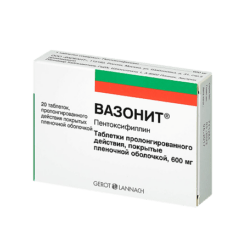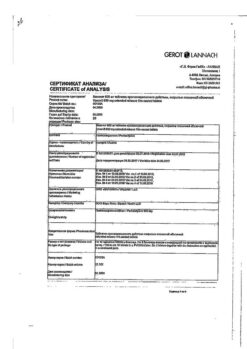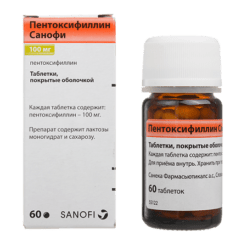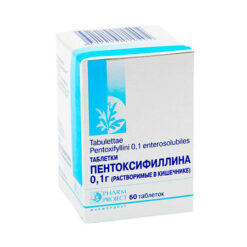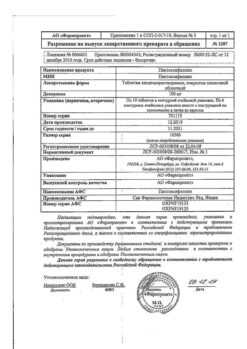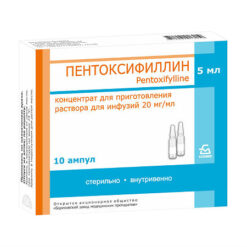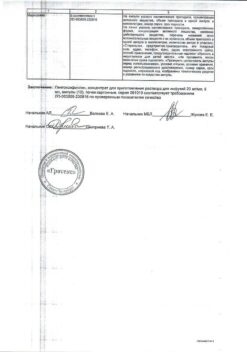No products in the cart.
Sanofi Pentoxifylline SR, 400 mg 20 pcs
€13.87 €11.56
Out of stock
(E-mail when Stock is available)
Description
Pentoxifylline improves microcirculation and the rheological properties of the blood.
. The mechanism of action is associated with inhibition of phosphodiesterase enzyme and increase of cyclic adenosine monophosphate (cAMP) in platelets and adenosine triphosphate (ATP) in erythrocytes with simultaneous saturation of energy potential, which in turn leads to vasodilation, reduction of total peripheral vascular resistance (TPR), increase of stroke and minute blood volume without significant change in heart rate (HR).
. Pentoxifylline reduces blood viscosity, increases erythrocyte membrane elasticity (due to influence on pathologically changed erythrocyte deformability), decreases erythrocyte, platelet and neutrophil aggregation, decreases blood fibrinogen content, decreases leukocyte adhesiveness to vascular endothelium, reduces leukocyte stimulation and, as a result, endothelium destruction.
It improves microcirculation in the areas of impaired blood circulation. In occlusive diseases of the peripheral arteries (“intermittent” claudication) leads to a prolongation of walking distance, the elimination of cramps of the calf muscles at night and pain at rest.
Indications
Indications
– Cerebrovascular disease (consequences of cerebral atherosclerosis, such as concentration disorders, dizziness, memory impairment), ischemic and post-stroke conditions.
– Trophic disorders of tissues due to arterial or venous microcirculation disorders (trophic ulcers, post-thrombophlebitic syndrome, frostbite, gangrene).
– Circulatory disorders in the vessels of the eye (acute and chronic circulatory insufficiency in the retina or in the vasculature of the eye).
– Middle ear disorders of vascular genesis, accompanied by hearing loss.
Active ingredient
Active ingredient
Composition
Composition
Each tablet contains:
the active ingredient:
pentoxifylline 400 mgg;
excipients:
core:
Hypromellose 2200/15000 – 0.12000 g, povidone 40 – 0.01650 g, talc – 0.01050 g, magnesium stearate – 0.00300 g;
coating:
Sepifilm 752 white (hypromellose – 35.0%-45.0%, microcrystalline cellulose – 27.0%-37.0%, macrogoal stearate – 6.0%-10.0%, titanium dioxide – 18.0%-22.0%) – 0.01500 g, dimethicone emulsion – 0.000075 g, macrogoal 6000 – 0.000175 g.
How to take, the dosage
How to take, the dosage
Orally, without chewing, regularly, at the same time, during or after meals, with plenty of water.
Cerebrovascular disease: 400 mg 2-3 times a day or 600 mg 1-2 times a day.
Peripheral artery occlusive disease stage II (“intermittent” claudication): 400 mg 3 times daily or 600 mg 2 times daily. The daily dose is 1200 mg.
Tissue trophic disorders due to arterial or venous microcirculatory disorders: 400 mg 2-3 times a day or 600 mg 1-2 times a day.
The maximum daily dose is 1200 mg.
The duration of treatment and the dosing regimen of pentoxifylline are determined by the attending physician individually, depending on the clinical picture of the disease and the therapeutic effect obtained.
Patients with hepatic dysfunction
Patients with impaired renal function
Patients with impaired renal function
CKC below 30 ml/min: caution should be exercised and the dose of the drug may be reduced by 50-70%.
Children and adolescents
Interaction
Interaction
Hypotensive agents
Medicinal products affecting the clotting system
When pentoxifylline and indirect anticoagulants (vitamin K antagonists) are used together, cases of increased anticoagulant effect (risk of bleeding) were noted in post-marketing studies. Therefore, it is recommended to monitor the degree of anticoagulant effect in patients taking this combination of drugs (e.g., regular monitoring of the international normalized ratio (INR)) at the beginning of pentoxifylline administration or change of its dose.
Cimetidine
Cimetidine may increase plasma concentrations of pentoxifylline and active metabolite I (risk of adverse reactions).
Other xanthines
The co-administration with other xanthines may lead to excessive jitters.
Hypoglycemic drugs (insulin and oral hypoglycemic agents)
Theophylline
Ciprofloxacin
Valproic acid
Platelet aggregation inhibitors
Special Instructions
Special Instructions
Treatment should be performed under BP control.
In patients who have recently undergone surgery, systematic monitoring of hemoglobin and hematocrit is necessary.
If retinal hemorrhages occur in patients during the use of the drug, the drug should be discontinued immediately.
Contraindications
Contraindications
– Hypersensitivity to pentoxifylline, other methylxanthine derivatives or other constituents of the drug.
– Acute myocardial infarction.
– Massive bleeding (risk of increased bleeding).
– Retinal hemorrhage (risk of increased bleeding).
– Acute hemorrhagic stroke.
– Pregnancy.
– Period of breastfeeding.
– Age under 18 years (effectiveness and safety not established).
Use with caution in patients with marked decreased blood pressure (BP) (risk of further BP decline) and hemodynamically significant heart rhythm abnormalities; chronic heart failure (CHF); severe hepatic impairment (risk of cumulation and increased risk of side effects); renal impairment (creatinine clearance (CQ) less than 30 ml/min) (risk of cumulation and increased risk of side effects); gastric and duodenal ulcer disease; with increased tendency to bleeding, e.g., as a result of using indirect anticoagulants [vitamin K antagonists] or with disorders in the blood clotting system (risk of more severe bleeding); after recent surgical intervention (risk of bleeding); with proliferative diabetic retinopathy.
Side effects
Side effects
The incidence of adverse reactions was determined in accordance with the classification of the World Health Organization: very common (⥠1/10); common (⥠1/100 and < 1/10); infrequent (⥠1/1000 and < 1/100); rare (⥠1/10000 and < 1/1000); very rare (< 1/10000), the frequency is unknown (cannot be calculated based on available data).
Nervous system disorders: frequency unknown – headache, dizziness, seizures, aseptic meningitis.
Psychiatric disorders: frequency is unknown – agitation, sleep disturbances, anxiety.
Cardiac disorders: frequency unknown – tachycardia, arrhythmia, angina pectoris, decreased BP.
Vascular disorders: frequency is unknown – “rushes” of blood to the skin, bleeding (including bleeding from the blood vessels of the skin, mucous membranes, gastrointestinal bleeding, nose bleeding).
Skin and subcutaneous tissue disorders: frequency unknown – skin itching, rash, erythema (skin redness), urticaria, edema, increased nail fragility.
Gastrointestinal disorders: frequency unknown – anorexia, bowel atony, epigastric discomfort, abdominal bloating (feeling of full stomach), vomiting, diarrhea, dry mouth, constipation, hyper-salivation (increased salivation).
Visual disorders: frequency is unknown – visual impairment, scotoma.
Blood and lymphatic system disorders: frequency unknown – thrombocytopenia, leukopenia/neutropenia, pancytopenia, hypofibrinogenemia.
Immune system disorders: frequency unknown – anaphylactic/anaphylactoid reactions, angioedema, anaphylactic shock, bronchospasm.
Hepatic and biliary tract disorders: frequency unknown – intrahepatic cholestasis, increased alanine aminotransferase (ALT) and aspartate aminotransferase (ACT) activity, increased alkaline phosphatase activity.
Overdose
Overdose
Symptoms: dizziness, nausea, “coffee grounds” type vomiting, marked BP decrease, tachycardia, arrhythmia, flushed skin, loss of consciousness, chills, areflexia, tonic-clonic convulsions.
In case of any of the above-mentioned disorders, it is necessary to see a physician urgently.
Treatment: treatment is symptomatic. If the first signs of overdose occur (sweating, nausea, cyanosis) the drug administration should be stopped immediately. If the drug has been taken recently, measures aimed at preventing further absorption of the drug by eliminating it (gastric lavage) or slowing down absorption (e.g., taking activated charcoal) should be provided. Special attention should be paid to maintaining BP and respiratory function. Diazepam is administered for seizures.
A specific antidote is not known.
Similarities
Similarities
Additional information
| Shelf life | 3 years. Do not use after the expiration date. |
|---|---|
| Conditions of storage | No special storage conditions required. Store out of the reach of children. |
| Manufacturer | Zentiva k.s., Czech Republic |
| Medication form | sustained release tablets |
| Brand | Zentiva k.s. |
Other forms…
Related products
Buy Sanofi Pentoxifylline SR, 400 mg 20 pcs with delivery to USA, UK, Europe and over 120 other countries.


